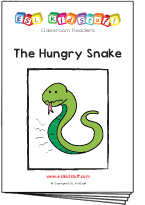Likes & dislikes lesson plan
Stand-alone lesson ESL kids lesson plan
Lesson plans for ESL kids teachers
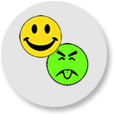
Likes & dislikes
In this lesson students practice by talking about likes and dislikes for food. Students sing a song about food, do a craft activity, read a funny story and play a board game.
Members get accompanying flashcards, worksheets, song and classroom reader.
Download materials:
Our lesson plans are FREE!
Sign up for accompanying:
✔ worksheets
✔ homework sheets
✔ craft sheets
✔ flashcards
✔ song downloads & videos
✔ classroom readers & videos
Click to see lesson details, materials and supplies
Time: 40 mins – 1 hour
Objectives: Talking about likes and dislikes for food.
Structures: “I like ~”, “I don’t like~”, “What a stink!”
Target vocabulary: cheese, chocolate, rice, French fries, strawberries, bread, ice cream, grapes, pasta, pizza, beans, food, drink, very nice, yummy, yuk.
Lesson materials
Flashcards:
- cheese, chocolate, rice, French fries, strawberries, bread, ice cream, grapes, pasta, pizza, beans.
Printables:
- I don’t like cheese song worksheet
- Funny food likes & dislikes game handout
- Food likes & dislikes 1 or Food likes & dislikes 2 worksheets (depending on the level of your students)
- Reader worksheet
- I don’t like cheese song poster
Songs:
- I don’t like cheese
Readers:
- The hungry snake
Additional materials:
- Likes & dislikes vocab crossword
- Likes & dislikes vocab word search
- Mary’s likes worksheet
Supplies:
- [hide_on_uk]colored[/hide_on_uk][hide_on_us]coloured[/hide_on_us] crayons / pencils
- Blu-Tack or something to stick flashcards on the board
- scissors
- glue
- supermarket magazines (with lots of food and drink pictures)
- A3 paper or construction paper to stick the magazine pictures on (1 sheet per student)
- dice (enough for each group of 3 or 4 students)
- device to play the song on
This lesson introduces students to simple structures for likes and dislikes. As the lesson is based around food and drink vocabulary it should be done after lessons on food, otherwise the food vocabulary should be pre-taught at the beginning of this lesson.
Lesson procedure:
Warm up and maintenance:
The beginning of your lesson is extremely important: this is where you set the tone of your lesson and get everyone in the right frame of mind for learning English. It is also an opportunity to check homework and review previous lessons.
Click for warm up suggestions for the start of your lessons
These activities can be done in the following order at the start of your lesson:
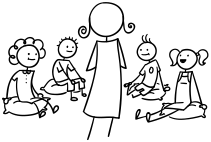
1. Welcoming
Greet the students by name as they enter the classroom and gesture for them to sit down. If you have space on the floor, it’s a good idea to have a cushion for each student as this makes sitting arrangements easy to [hide_on_uk]organize[/hide_on_uk][hide_on_us]organise[/hide_on_us]. Try and arrange the cushions beforehand spaced out in a fan-shape around you.

2. Name tags
Before class prepare some name tags (stickers or pin-on tags) with each student’s name written in lower case letters. Sit down with your students and lay out the name tags in front of you. Pick up each tag and call out the name. Try and encourage each student to put their hand up and say “yes”. Hand over the tags and help to pin / stick on. Later on as your students recognize their written names you can have each student in turn pick out their own name tag.

3. Greetings
Use a glove puppet (such as a Sesame Street puppet) to greet the students. Keep him in a cloth bag. Bring out the bag, open it enough to see in and shout into the bag the puppet’s name (e.g. “Cookie Monster!”). Then move your ear to the opening to listen – nothing. Go to each student and encourage them to shout the puppet’s name into the bag – each time nothing happens. Finally, get all the students together to shout the name at the same time. This time the puppet wakes up and jumps out of the bag! The puppet then chats to each student:
Puppet (teacher): Hello, What’s your name?
Student Hello. My name is….
Puppet: Goodbye / See you!
Student: Goodbye / See you!
As your students learn more phrases, you can include them in the conversation, such as “How old are you? Do you like …?, Can you …?, etc.
Finally, the puppet goes back into the bag and back to sleep.
4. Sing the “Hello song” or a review song
Sit in a circle and sing along to the song. Encourage students to clap along or pat their laps in time with the music. The Hello song is a good song to start the lesson with, especially as it has an accompanying Goodbye song to sing at the end of the lesson.
Lyrics for the “Hello song”
Hello, hello, Hello, hello,
How are you? How are you?
I’m fine, thank you, I’m fine, thank you,
We’re ok, We’re ok.
Lyrics for “The Hello Song”
Hello, hello,
How are you today?
Hello, hello,
How are you today?
I’m fine, thank you,
I’m fine, thank you,
I’m fine, thank you,
And how about you?
Hello, hello,
How are you today?
I’m fine, thank you,
And how about you?
Gestures for the “Hello song”
These are quite straight forward. First time you play the song do the gestures and encourage everyone to do them with you.
- Wave as you sing the “Hello, hello” parts.
- Gesture to others as you sing, “How are you today?”
- Point to yourself as you sing, “I’m fine, thank you”
- Hand gesture towards another student as you sing, “And how about you?”.

[hide_on_uk]Short sample (members get full-length song):
[/hide_on_uk]
[hide_on_us]Short sample (members get full-length song):
[/hide_on_us]
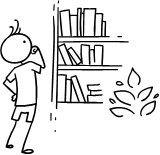
5. Read a classroom reader again
As you progress through the lessons you will start to build up a catalog of classroom readers. Kids love going back to old stories and reading through them again. Invite a student to pick a classroom reader and read through it as a class. Make the story as interactive as possible by asking questions (e.g. what [hide_on_uk]colors[/hide_on_uk][hide_on_us]colours[/hide_on_us] there are, the names of different objects, etc.) and getting students to speculate what is going to happen next in the story.

6. Homework check
Check each student’s homework set in the last lesson. Ask each student some questions about their homework worksheet (e.g. “what [hide_on_uk]color[/hide_on_uk][hide_on_us]colour[/hide_on_us] is it?”), give lots of praise, and then put some kind of mark on the homework sheet (e.g. a sticker, a stamp or draw a smiley face). Finally, tell your students to put their homework back into their bags.
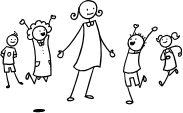
7. Do “Exercise routine” activity
Say the following and have your students follow your lead: “Stand up (teacher stands and so does everyone else), “Hands up / hands down” (x 3-5), “Jump” (x3-5), “Run! / Stop!” (x3-5), “Turn around! / Stop!” (x3-5), finally “Sit down”.
Throughout the course you can introduce other commands, such as “Hop”, “Star Jump”, “Wiggle”, “Crouch” and so on.
Extra activity: Once your students have got to know these exercises you can play “Teacher says” using these actions.
This is basically the game ‘Simon says’ but using the words “Teacher says” instead. The teacher tells the students to do an action and they do as asked (e.g. “Teacher says … jump 3 times”). The teacher keeps on giving instructions with different actions using “Teacher says …”. At some point the teacher gives a command without using the phrase “Teacher says” (e.g. “Hop 5 times”) and the students must not do that action – they have to stay still. Any students that do the action have to sit out for the rest of the game. The last student standing is the winner.
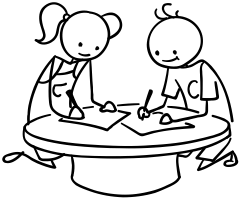
8. Name writing practice
If your students cannot write their names yet, this is a great activity. For really young ones, don’t worry if their effort is a scrawly mess – always encourage and praise.
You will need to prepare a writing sheet for each student before class with their name written in dots for them to practice tracing their names (also prepare one for yourself so you can model the task). You can either make these yourself (hand draw the dots for each name) or use a font typed into a Word document – we like to use the “National First Font Dotted” font (you can download it for free here: http://www.fontspace.com/roger-white/national-first-font-dotted).
Prepare the sheets something like this:

Make a few extra copies of each student’s name writing sheet so you can use them in future lesson or for homework.
When everyone has finished writing their names, get each student to hold up their sheet so you and everyone can see. Give lots of praise to each student.
9. Review past lessons
Reviewing past lessons is very important – students need constant practice of new vocab, structures, songs, games and so on. Always review parts of your last lesson as well as some parts from other previous lessons. You can spend 5-10 minutes reviewing – it’s fine to recycle games and activities from your past lessons to review as kids enjoy playing familiar games (although be careful not to play a game to death!).
Note: You can also include review activities in the main body of your lesson. Kids can have short attention spans so it’s good to be able to pull out lots of activities during different stages of the lesson.
Other ideas to include in your warm up:
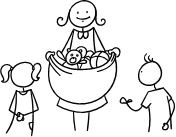
What’s in the bag?
This is a great activity to do at the beginning of your lessons. Fill a large cloth bag with items from your previous lessons (e.g. plastic fruit, animals, etc.). You can also throw in a few other objects (e.g. a pencil, a plastic bottle, a plastic cup – anything lying around (and safe!)). Show the bag to your students and shake it to rattle the objects inside. Pull out different objects, teach/elicit their names, have students hold and pass the objects around. You can even have students pull objects out of the bag. Pull out 1 or 2 objects per student. Finally, place the objects around the classroom and have each student retrieve each object as you call out its name and put it back in the bag.
Knock-knock
This can be used at the beginning of each class. Teach the students to knock on the door before entering the classroom. There are 2 variations for the next step:
- When the student knocks, teacher says, “Who’s there?”. The student replies, “It’s (Koji)” and then the teacher says, “Come in (Koji)”.
- When the student knocks the teacher must guess who it is, “Is that (Koji)?”. The student replies yes or no – if no, the teacher continues guessing. Having your students develop their own knocking styles makes this even more fun.

Spin the bottle
Sit students in a circle with a bottle in the middle. Teacher spins the bottle. When it stops spinning the student it is pointing at has to answer a question. If the answer is correct then that student can spin the bottle. For example, How are you? What’s your name? What is this? (show an object or flashcard) Do you like _?, etc.

Talk about the weather (do after you have taught the weather lesson plan).
- Prepare a weather board. Before the first class prepare a piece of cardboard and cover it with felt – you are going to pin this to the wall. If you can, try and get blue felt (to represent the sky). Write at the top in large letters, “How’s the weather today?”. Below the write “Today it’s”. Cut out weather pictures (such as our weather flashcards) and stick some velcro on the back. Arrange the weather pictures around the edge of the board and then put the board on the wall of your classroom. You can now use this weather board at the beginning of every lesson.
- Sing “The weather song”. Sing the song together doing all of the gestures.
- Look outside. Get everyone to look outside by saying, “How’s the weather? Look outside”. Elicit the weather for that day.
- Put the weather pictures on the weather board. Invite some students to come up and put the weather pictures on the board. Make sure these students say the word as they put the card on the board.
New learning and practice:
1. Introduce “I like” and “I don’t like”
Start off by preparing your board as shown below (without the food drawings). Also, have the following flashcards printed out (just in case): cheese, chocolate, rice, French fries, strawberries, bread, ice cream, grapes, pasta, pizza, beans.
The board should be divided into two sections: “likes” on the left and “dislikes” on the right (indicated with a smiley and unhappy face).
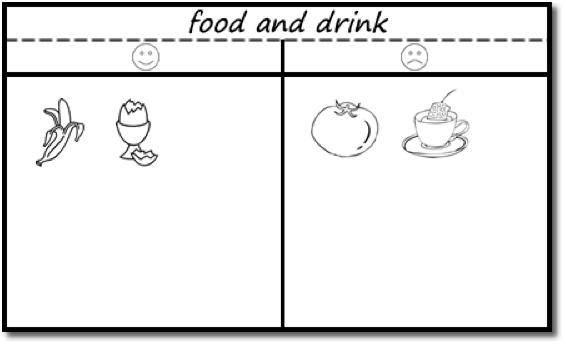
As a class you are going to draw food and drink items you like and don’t like, as follows:
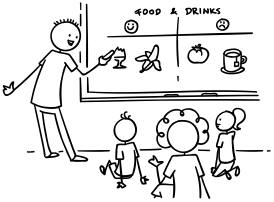
- First, draw a food or drink in the ‘like’ column (such as a banana). Get everyone to shout out what you have drawn. Gesture that you like this (say, “Yummy!” and rub your tummy and smile – make it obvious that you like it a lot). Say, “I like bananas”.
- Next, draw something in the ‘dislike’ column (such as a tomato). Again, get everyone to shout out what you have drawn. Gesture that you don’t like this (say, “Yuk!” or “It stinks!” and grimace – make it obvious that you don’t like it). Say, “I don’t like tomatoes”.
- To make sure everyone understands, draw another food/drink item in the ‘like’ and ‘dislike’ columns, using the same structures and gestures as before. This will turn into a fun guessing game as everyone tries to guess what is being drawn.
- Next, your students are going to draw some pictures on the board. Invite a student up and point to the ‘like’ column and say, “Draw a food or drink that you like”. When the student draws the item, everyone has to guess what it is. Then get the student to say, “I like ~”. The next student should draw something in the ‘dislike’ column and say, “I don’t like ~”. Keep bringing students up to the board to draw their likes and dislikes until the board is pretty full.
- If any of the items from the song haven’t been drawn (cheese, chocolate, rice, French fries, strawberries, bread, ice cream, grapes, pasta, pizza, beans) use the flashcards to get them on the board: hold up each picture and elicit the word, then ask students to place the flashcard (use Blu-Tack or tape) on the board in the column of their choice (whilst saying “I like ~” or “I don’t like~”).
2. Controlled Practice saying “I like ~” and “I don’t like ~”
Put the students into pairs. They are going to make sentences using the food and drink items on the board. Model with a student first so everyone understands what to do:
Teacher says, “banana” – choosing an item from the board.
The student has to make a sentence (e.g. “I like bananas”), The answer should be the student’s own true answer.
Then in pairs, students take turns in choosing a food item for their partner to make a sentence about. For example:
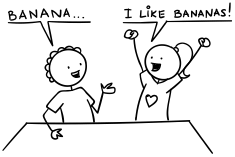
Student A: apples
Student B: I like apples!
Student B: carrots
Student A: I don’t like carrots!
Also, encourage the use of phrases such as “Yummy”, “Yuk” and “It stinks”. Pairs keep talking until they have gone through all of the items on the board.
3. Play the song “I don’t like cheese” and students fill in their worksheets
For this song, students listen and fill in their “I don’t like cheese song” worksheets by drawing the different food items they hear. The song runs through the vocabulary pretty quickly, so play the song at least twice.
After playing the song a few times, elicit the answers and put the flashcards on the board in the right columns so everyone can check (there will only be “cheese” in the ‘I don’t like’ column). Play the song through once more, pointing at the items on the board – encourage everyone to sing along. Alternatively, you could use the “I don’t like cheese” song poster.
Lyrics for “I don’t like cheese”
Verse 1:
I like chocolate,
I like rice,
I like French fries,
They’re very nice,
I like strawberries,
I like bread,
Oh no, what’s that?
I don’t like cheese!
Chorus:
Cheese, cheese,
I don’t like cheese,
Cheese, cheese,
Don’t give me, please!
I like lots of food,
I like lots of drink,
But as for cheese – what a stink!
Verse 2:
I like ice cream,
I like grapes,
I like pasta,
It tastes great!
I like pizza,
I like beans,
Oh no, what’s that?
I don’t like cheese!
Chorus
Gestures for “I don’t like cheese”
There are no gestures for this song – a listening activity with worksheet accompanies the song. However, if students enjoy the song you can encourage them to sing along and dance!
The worksheet to use during the song is the “I don’t like cheese song worksheet”.
Students listen to the song and draw the food items they hear in the ‘I like’ and ‘I don’t like’ columns (only cheese is in the “don’t like” column).
The song runs through the vocabulary pretty quickly, so play the song at least twice.

[hide_on_uk]Short sample (members get full-length song):
[/hide_on_uk]
[hide_on_us]Short sample (members get full-length song):
[/hide_on_us]
4. Read classroom reader “The hungry snake”
This story ties in nicely with the song (the snake likes lots of food but doesn’t like cheese). Before class, download and print off the reader “The hungry snake”. As you go through each page, point to the pictures and elicit each key word, for example:
Teacher: What is the snake eating?
Students: Chocolate!
Teacher: I like chocolate, yummy! How about you (Emi)?
Student (Emi): I like chocolate! Yummy!
Get the students really involved in the story by asking lots of questions (e.g. eliciting [hide_on_uk]colors[/hide_on_uk][hide_on_us]colours[/hide_on_us] and other objects). Be sure to point out the snake’s tummy getting bigger on each page.

After reading the story, give out a reader worksheet to each student and have everyone draw lines to the food mentioned in the story. Then read through the story one more time (without stopping for questions, etc.) to check the answers as a class.
Alternatively, watch our video version of the reader (Internet connection required).
5. Magazine cut outs
Now everyone is going to make a poster showing the food and drink they like / dislike. You will need some supermarket magazines for this – many supermarkets have free magazines showing the food they have on sale – collect as many as you can before the lesson. Give each student a large piece of paper (construction paper or card, if possible), scissors, glue and a magazine (you can group students together to share magazines).
On the paper, each student should write their name at the top and then make a table with two columns titled “I like …” and “I don’t like”. Then they can go through the magazines and cut out and glue food and drink pictures into the correct column on their posters.
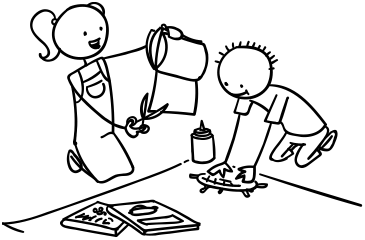
As the students are working on this, circulate, help out with vocabulary and ask questions (e.g. What’s this?, Do you like ~ ?, etc.).
When everyone has finished, get each student to hold up their posters and explain what they like and dislike. If you have a large class, you can do this in pairs or groups.
6. Play the “Funny food likes & dislikes game”
This is a really fun way to end the lesson. You will need put the class into groups of 3 or 4 and give each group a die and the “Funny food likes & dislikes game” handout (if you can, enlarging it to A3 size it would be better):
Before the game starts write the following on the board:
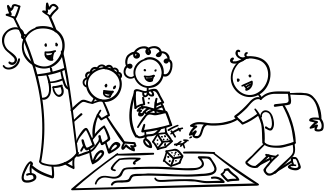
- pizza
- soup
- ice cream
- sandwich
- juice
- cake
- Play the game in groups of 3 or 4. Everyone sits around the game board. Decide who goes first and play in a clockwise direction around the game board.
- Player 1 rolls a die onto the game board paper. Look at which food item it lands on and the number of the die.
- The player must then make a sentence with the food item and using the number on the board. E.g. If the die lands on the cheese picture and number 3 s/he must say:
“I don’t like cheese ice cream!”
or
“I like cheese ice cream” (in this case, probably not!) - Cross out that picture with a pencil.
- The next player must roll the die. If the die lands on a crossed out picture s/he misses a turn (also miss a turn if the die doesn’t land on a picture at all). If the die lands on a new picture, s/he must make another like / don’t like sentence.
- The game continues until all of the pictures are crossed out.
At the end of the game you can ask everyone to tell you the strangest thing they made a sentence about (e.g. “I don’t like hamburger ice cream!”)
Wrap up:
Assign homework: “Food likes & dislikes 1” or “Food likes & dislikes 2” worksheet
Select the worksheet that best fits the level of your students.
Click for wrap up suggestions for the end of your lessons

1. Assign homework
Each week give out a homework worksheet for your students to take home. Hold up the homework worksheet and model how to do it. Give out the worksheets and say, “Put your homework in your bags” and help them to do so – this is important as they will probably want to start [hide_on_uk]coloring[/hide_on_uk][hide_on_us]colouring[/hide_on_us] them right away.
If possible, encourage the parents to help out as much as possible with their child’s homework – it is a great way to have your students practice the target language outside of class.

2. Say goodbye to glove puppet
Take out the bag again and get everyone to wake up the glove puppet by shouting its name into the bag (e.g. “Cookie Monster!”). Bring out the puppet and go through the same routine – go to each student and say hello, ask their name and the say goodbye / see you. Then put the puppet back in the bag (back to sleep).
3. Sing the “Goodbye song”
The “Goodbye song” is a great way to sign off the class. Sit together in a circle and sing and clap along. You can also use a different song, especially if your students love a particular song.
Lyrics for the “Goodbye song”

Goodbye, goodbye,
See you again.
Goodbye, goodbye,
See you again.
It’s time to go,
It’s time to go,
It’s time to go,
See you next time.
Goodbye, goodbye,
See you again.
It’s time to go,
See you next time.
Gestures for the “Goodbye song”
These are quite straight forward. First time you play the song do the gestures and encourage everyone to do them with you.
- Wave as you sing the “Goodbye, goodbye” parts.
- Hold your hand above your eyes (as you would when you are looking into the distance and keeping the sun out of your eyes) and look at another student as you sing, “See you again”.
- Tap watch (or imaginary watch) and then point to the door as you sing, “It’s time to go”.
- Point towards another student as you sing, “See you next time”.
[hide_on_uk]Short sample (members get full-length song):
[/hide_on_uk]
[hide_on_us]Short sample (members get full-length song):
[/hide_on_us]

4. Do “Quick check” and say goodbye
Time to leave the class. Make sure everything is put away and the students have gathered their belongings. Have them line up at the door and place yourself between the door and the students. For each student check one new word or phrase, for example:
- hold up an object or flashcard (such as a [hide_on_uk]color[/hide_on_uk][hide_on_us]colour[/hide_on_us] or fruit) and ask, “What’s this?”
- say an action for the student to do (e.g. “Roar like a lion”, “Jump 5 times”, etc.)
- ask a question from the lesson (e.g. “How old are you?”, “Do you like bananas?”, “Can you play chess?”, etc.).
- for very young students you can hold up one of the worksheets you did in the lesson and ask them to touch an object (e.g. “Touch the melon”).
When they give you the correct answer say goodbye and let them leave. If their answer is wrong, have them go back to the end of the line – they will have to try again once they reach the front!
Other lesson plans
Actions, verbs & tenses:
- Can – for ability
- Morning routines
- Daily routines & times of the day
- Actions – Present continuous
- Future plans using “going to”
- Past tense activities – Regular verbs
- Past tense activities – Irregular verbs: Part 1
- Past tense activities – Irregular verbs: Part 2
Adjectives:
- Describing people
- Describing things
- Comparing things (Comparative adjectives)
- Comparing things (Superlative adjectives)
Adverbs:
Alphabet:
Animals:
Body:
Classroom:
Clothes:
Colors:
Colours:
Directions:
Family:
Feelings & emotions:
Food:
Health & sickness:
Holidays & festivals:
Jobs:
Likes, dislikes & favorites:
Likes, dislikes & favourites:
- Likes & dislikes
- [hide_on_uk]Favorites[/hide_on_uk][hide_on_us]Favourites[/hide_on_us] and asking why
Nature & Our world:
Numbers:
Places & where we live:
Prepositions of location:
Pronouns:
Shapes:
Shopping:
Sports:
Time, days, months, seasons:
Toys:
Transport & travel:
Weather:


